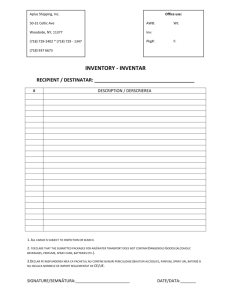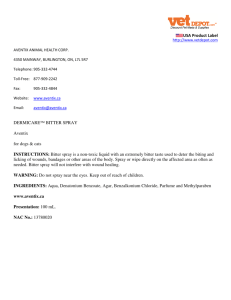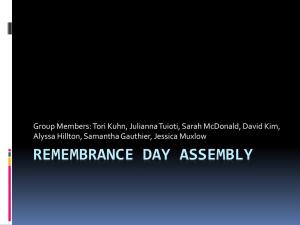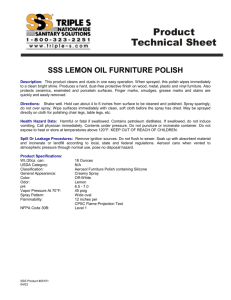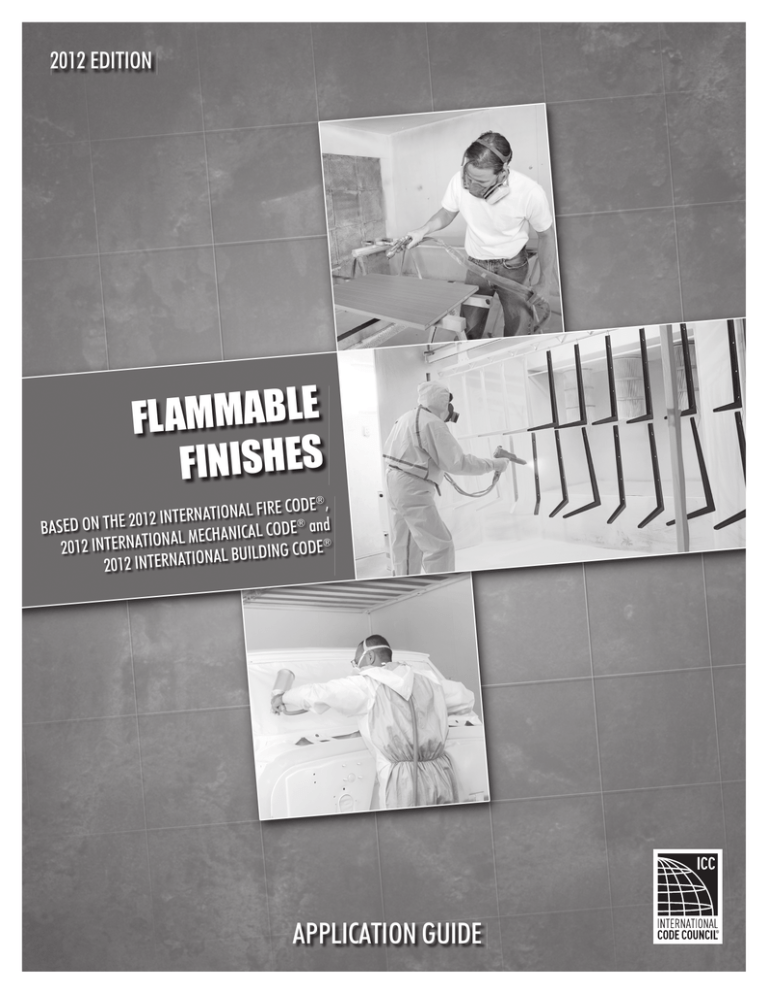
2012 EDITION
FLAMMABLE
FINISHES
DE®,
CO
E
R
FI
L
A
N
O
TI
A
INTERN
BASED ON THE 2012
CODE® and
L
A
IC
N
A
H
EC
M
L
A
2012 INTERNATION
CODE®
G
IN
D
IL
U
B
L
A
N
O
2012 INTERNATI
APPLICATION GUIDE
Flammable Finishes Application Guide: 2012Edition
ISBN: 978-1-6098-465-4
Cover Art Design:
Lisa Triska
Editor:
Mary Lou Luif
Project Manager:
Terrell Stripling
Instructional Designer:
Valerie Pang
Publications Manager:
Mary Lou Luif
Typesetting/Interior Design:
Cheryl Smith
COPYRIGHT © 2013
ALL RIGHTS RESERVED. This publication is a copyrighted work owned by the International Code Council, Inc. Without advance written permission from the copyright owner, no part of this book may be reproduced, distributed or transmitted in any form or by any means, including, without limitation, electronic, optical or mechanical means (by way of example, and not limitation, photocopying or recording by or in an
information storage retrieval system). For information on permission to copy material exceeding fair use, please contact: Publications, 4051
West Flossmoor Road, Country Club Hills, IL 60478. Phone 1-888-ICC-SAFE (422-7233).
The information contained in this document is believed to be accurate; however, it is being provided for informational purposes only and is
intended for use only as a guide. Publication of this document by the ICC should not be construed as the ICC engaging in or rendering engineering, legal or other professional services. Use of the information contained in this workbook should not be considered by the user to be a substitute for the advice of a registered professional engineer, attorney or other professional. If such advice is required, it should be sought through
the services of a registered professional engineer, licensed attorney or other professional.
Trademarks: “International Code Council,” the “International Code Council” logo and the “International Building Code” are trademarks of International Code Council, Inc.
Errata on various ICC publications may be available at www.iccsafe.org/errata.
First Printing: February 2013
PRINTED IN THE U.S.A.
36523 - T013968-2-22-13
Table of Contents
Preface ................................................................................................................................. v
About the Author............................................................................................................... vii
Acknowledgements............................................................................................................ ix
Overview .............................................................................................................................. 1
Description .......................................................................................................................... 1
Goal..................................................................................................................................... 1
Objectives ........................................................................................................................... 1
Target Audience.................................................................................................................. 1
Explanation of Icons............................................................................................................ 2
Margin Designation Within Code Book ............................................................................... 3
Module 1 Introduction to Chapter 24 of the International Fire Code® ........................... 5
Introduction ......................................................................................................................... 5
Introduction to Spray Finishing and Its Hazards ................................................................. 8
Introduction to Powder Coating and Its Hazards................................................................. 9
Introduction to Reinforced Plastic and Its Hazards ........................................................... 10
Module 2 Protection of Operations.................................................................................. 13
Introduction ....................................................................................................................... 13
Electrical Sources of Ignition............................................................................................. 13
Bonding and Grounding .................................................................................................... 19
Open Flames and Other Ignition Sources......................................................................... 20
Storage, Use and Handling of Flammable and Combustible Liquids................................ 22
Operations and Maintenance ............................................................................................ 25
Module 3 Spray Finishing................................................................................................. 29
Introduction ....................................................................................................................... 29
Design and Construction of Spray Rooms, Spray Booths and Spray Spaces .................. 32
Means of Egress ............................................................................................................... 35
Clearances ........................................................................................................................ 36
Size of Spray Booths......................................................................................................... 37
Fire Protection................................................................................................................... 39
Portable Fire Extinguishers ............................................................................................... 41
Housekeeping, Maintenance and Storage of Hazardous Materials .................................. 42
Sources of Ignition ............................................................................................................ 43
Illumination ........................................................................................................................ 46
Mechanical Ventilation ...................................................................................................... 48
Exhaust Ducts ................................................................................................................... 56
Interlocks........................................................................................................................... 64
Limited Spray Spaces ....................................................................................................... 65
iii
Module 4 Dipping Operations ...........................................................................................69
Introduction ........................................................................................................................69
Location of Dip-tank Operations ........................................................................................71
Construction of Dip Tanks .................................................................................................72
Fire Protection ...................................................................................................................74
Mechanical Ventilation and Interlocks ...............................................................................75
Hardening and Tempering Tanks ......................................................................................76
Module 5 Powder Coating .................................................................................................79
Introduction ........................................................................................................................79
Location and Construction of Powder Coating Booths or Rooms......................................80
Fire Protection ...................................................................................................................82
Operations and Maintenance.............................................................................................83
Sources of Ignition .............................................................................................................85
Mechanical Ventilation .......................................................................................................88
Module 6 Indoor Manufacturing Of Reinforced Plastics ................................................91
Introduction ........................................................................................................................91
General Requirements.......................................................................................................92
Fire Protection ...................................................................................................................95
Housekeeping, Maintenance, Storage and Use of Hazardous Materials ..........................97
Sources of Ignition in Resin Application Areas ..................................................................98
Mechanical Ventilation .......................................................................................................99
Answers ............................................................................................................................101
Notes .................................................................................................................................102
iv
Preface
Preface
A variety of processes and materials are available for the application of
flammable finishes. Liquids can be atomized into aerosol and sprayed on
objects. Goods can be immersed into open dip tanks. In a process known
as powder coating, ionized solids are suspended in air and attached to
metal objects after being electrically charged. Rigid thermoplastics are
manufactured using glass fibers that are applied with a resin and a chemical catalyst.
Chapter 24 of the 2012 International Fire Codes® (IFC®) contains the minimum requirements for flammable finishes. This application guide was
developed to assist code officials, design professionals and the regulated
community in understanding the IFC, International Mechanical Code®
(IMC®) and International Building Code® (IBC®) requirements and intent
for these hazardous activities.
This application guide is divided into six modules. Module 1 addresses the
general provisions of IFC Chapter 24 and includes an analysis of the hazards associated with flammable spray finishing, finishing using dip tanks,
powder coating and the manufacturing of rigid thermoplastics. Module 2
addresses the IFC requirements for the protection of operations. The
remaining modules address the IFC requirements for spray finishing, dipping activities, powder coating and the manufacturing of reinforced plastics. In addition, the application guide addresses the National Fire
Protection Association (NFPA) 33 requirements for spray finishing and
the NFPA 34 requirements for dip tanks. This application guide is
designed to assist users of the IFC in its proper application and use for
flammable finishes.
This application guide includes an extensive and detailed analysis of the
IMC requirements for hazardous exhaust ventilation systems and NFPA
Standard 70, National Electrical Code® requirements for hazardous (classified) location electrical equipment. Properly designed mechanical ventilation systems and properly specified and installed electrical equipment
that is designed to be resistant to the ignition of flammable liquid vapors
or combustible dusts are essential for the safe operation of equipment
or areas where flammable finishing occurs. These engineered systems
provide effective and economical control of ignition sources in flammable finish applications.
The information and opinions expressed in this application guide are
those of the author and do not necessarily represent the official position
of the International Code Council. Additionally, the opinions may not represent the viewpoint of any enforcing agency. Opinions expressed in this
publication are only intended to be a resource in the application of the
IFC, and the code official is not obligated to accept such opinions. The
code official is the final authority in rendering interpretations of the code
and its adopted standards.
v
Flammable Finishes Application Guide
Questions or comments concerning this application guide are encouraged. Please
direct any correspondence to applicationguide@iccsafe.org.
About the International Code Council®
The International Code Council (ICC), a membership association dedicated to
building safety, fire prevention and energy efficiency, develops the codes and
standards used to construct residential and commercial buildings, including
homes and schools. The mission of ICC is to provide the highest quality codes,
standards, products and services for all concerned with the safety and performance of the built environment. Most United States cities, counties and states
choose the International Codes, building safety codes developed by the International Code Council.
The International Codes also serve as the basis for construction of federal properties around the world, and as a reference for many nations outside the United
States. The International Code Council is also dedicated to innovation and sustainability. ICC Evaluation Service, a subsidiary of ICC, issues Evaluation Reports and
Listings for innovative building products as well as environmental documents
such as ICC-ES VAR Environmental Reports and ICC-ES Environmental Product
Declarations (EPDs).
Headquarters: 500 New Jersey Avenue, NW, 6th Floor,
Washington, DC 20001-2070
District Offices: Birmingham, AL; Chicago, IL; Los Angeles, CA
1-888-422-7233
www.iccsafe.org
vi
About the Author
About the Author
The Flammable Finishes Application Guide: 2012 Edition was initially developed
by Scott Stookey, former Senior Technical Staff member with the International Code Council and currently an Engineering Associate with the Austin,
Texas Fire Department. He is a fire protection engineer with over 20 years of
regulatory enforcement and emergency response experience. Scott is a graduate of the Fire Protection and Safety Engineering Technology program at
Oklahoma State University and has worked for the City of Austin (Texas) and
City of Phoenix (Arizona) Fire Departments. The changes incorporated into
the 2012 edition were made by Terrell Stripling, Technical Staff member with
the International Code Council.
vii
Flammable Finishes Application Guide
viii
Acknowledgements
Acknowledgements
The author expresses his sincere thanks to Traci Bangor, P.E., of the U.S. General Services Administration in Atlanta, Georgia, for her detailed and timely
review of the manuscript. Her skills and aptitude have promoted fire protection and fire safety around the world. The author also extends thanks to Tom
Izbicki, P.E., of Rolf Jensen & Associates in Dallas, Texas. Tom has been both a
design professional and regulatory official and is a member of ICC’s Fire Code
Development Committee. Finally, the author thanks Robert Neale, Director
of National Fire Programs at the United States Fire Administration. His work
at the National Fire Academy has advanced the profession of fire code
enforcement and improved fire fighter safety, which are admirable and continuing goals.
ix
Flammable Finishes Application Guide
x
Module 3
Module 3
Spray Finishing
Introduction
IFC Section 2404 addresses the construction of spraying spaces, spray booths and spray rooms; the application of flammable spray finishes; the location of spray
finishing operations; the design and construction of
spray rooms, spraying spaces and spray booths; fire
protection of spray rooms and booths; control of ignition sources; spray
room and spray booth mechanical ventilation systems; interlocks required for
spray-finishing activities and limited spray spaces. IFC Section 2404.1 requires
that spray-finishing activities also comply with the requirements in IFC Section 2403 for the protection of operations.
IFC Section 2404.2 regulates the location of spray-finishing operations:
2404.2 Location of spray-finishing operations. Spray finishing operations
conducted in buildings used for Group A, E, I or R occupancies shall be
located in a spray room protected with an approved automatic sprinkler system installed in accordance with Section 903.3.1.1 and separated vertically
and horizontally from other areas in accordance with the International Building Code. In other occupancies, spray-finishing operations shall be conducted
in a spray room, spray booth or spraying space approved for such use.
Exceptions:
1. Automobile undercoating spray operations and spray-on automotive lining operations conducted in areas with approved natural or mechanical
ventilation shall be exempt from the provisions of Section 2404 when
approved and where utilizing Class IIIA or IIIB combustible liquids.
2. In buildings other than Group A, E, I or R occupancies, approved limited
spraying space in accordance with Section 2404.9.
3. Resin application areas used for manufacturing of reinforced plastics
complying with Section 2409 shall not be required to be located in a
spray room, spray booth or spraying space.
In Group A, E, I and R occupancies, spraying operations must be conducted in
a spray room. IFC Section 202 defines a “Spray room” as follows:
Definitions
LIMITED SPRAYING SPACE.
An area in which operations for
touch-up or spot painting of a surface area of 9 square feet (0.84 m2)
or less are conducted.
SPRAY BOOTH. A mechanically
ventilated appliance of varying
dimensions and construction provided to enclose or accommodate
a spraying operation and to confine
and limit the escape of spray vapor
and residue and to exhaust it safely.
SPRAY ROOM. A room designed
to accommodate spraying operations constructed in accordance
with the International Building Code
and separated from the remainder
of the building by a minimum 1hour fire barrier.
A room designed to accommodate spraying operations constructed in accordance with the International Building Code and separated from the remainder
of the building by a minimum 1-hour fire barrier.
In the indicated occupancies, the spray room must be vertically and horizontally separated from the other portions of the building in accordance with the
requirements of IBC Table 509, Incidental Uses. For spray rooms, IBC Table
509 (under the provisions for paint shops) permits two separation options: a
minimum 2-hour fire-resistance-rated fire barrier isolating the spray room
29
Flammable Finishes Application Guide
from the remainder of the building or a combination of a minimum 1-hour fire-resistancerated fire barrier enclosing the spray room and an approved automatic fire-extinguishing
system within the spray room. Given the requirement in IFC Section 2404.3 for the installation of an IFC Section 903.3.1.1 (NFPA 13)-compliant automatic sprinkler system throughout Group A, E, I or R occupancies housing a spray room, the 1-hour fire-resistance-rated
separation option will be the most commonly used method to obtain compliance.
TABLE 509
INCIDENTAL USES
ROOM OR AREA
Furnace room where any piece of equipment is over 400,000
Btu per hour input
Rooms with boilers where the largest piece of equipment is
over 15 psi and 10 horsepower
Refrigerant machinery room
Hydrogen cutoff rooms, not classified as Group H
Incinerator rooms
Paint shops, not classified as Group H, located in occupancies
other than Group F
Laboratories and vocational shops, not classified as Group H,
located in a Group E or I-2 occupancy
Laundry rooms over 100 square feet
Group I-3 cells equipped with padded surfaces
Waste and linen collection rooms located in either Group I-2
occupancies or ambulatory care facilities
Waste and linen collection rooms over 100 square feet
Stationary storage battery systems having a liquid electrolyte
capacity of more than 50 gallons for flooded lead-acid, nickel
cadmium or VRLA, or more than 1,000 pounds for lithium-ion
and lithium metal polymer used for facility standby power,
emergency power or uninterruptable power supplies
SEPARATION AND/OR PROTECTION
1 hour or provide automatic sprinkler system
1 hour or provide automatic sprinkler system
1 hour or provide automatic sprinkler system
1 hour in Group B, F, M, S and U occupancies; 2 hours in
Group A, E, I and R occupancies.
2 hours and automatic sprinkler system
2 hours; or 1 hour and provide automatic sprinkler system
1 hour or provide automatic sprinkler system
1 hour or provide automatic sprinkler system
1 hour
1 hour
1 hour or provide automatic sprinkler system
1 hour in Group B, F, M, S and U occupancies; 2 hours in
Group A, E, I and R occupancies.
For SI: 1 square foot = 0.0929 m2, 1 pound per square inch (psi) = 6.9 kPa, 1 British thermal unit (Btu) per hour = 0.293 watts,
1 horsepower = 746 watts, 1 gallon = 3.785 L.
Paint shops (IBC terminology) that occur in other occupancy groups, except for Groups F
and H, must also be separated under the requirements of IBC Section 509.4 and Table 509.
Where a paint shop is located within a Group F occupancy, the provisions of IBC Table 509
do not apply; however, compliance with IBC Section 416.2 is still required. This results in a
minimum 1-hour fire barrier separation between the spray room and the remainder of the
building housing the Group F occupancy. Where the paint shop is classified as a Group H
occupancy, the required level of separation is mandated by IBC Section 508.4.4, and the
hourly rating of the required fire barrier separation is found in IBC Table 508.4.
The designation of a specific area as an “incidental use” does not change the overall occupancy classification of the use or area of the building or occupancy under the requirements of the IBC. For example, a Group A occupancy with a compliant, incidental-use
30
Module 3 Spray Finishing
spray room remains a Group A occupancy and does not become a Group H occupancy because of the spraying activity.
IBC Section 509.4.1 specifies the requirements of the fire-resistance-rated construction. For a spray room that is protected
by an approved automatic sprinkler system and constructed
inside of an occupancy other than Group F or H, the IBC mandates:
• The construction of fire barriers in accordance with IBC
Section 707 and horizontal assemblies, where applicable,
in accordance with IBC Section 711,
• Self-closing fire door assemblies with a minimum fire protection rating as specified in IBC Table 716.5.
Figure 3-1 shows a Group H-2 occupancy used as a spraying
room.
In Group A, E, I and R occupancies, the IFC requires that limited
spraying areas be separated from other portions of the building using the same methods as prescribed by the IBC for incidental uses. The IFC also requires the installation of an
automatic sprinkler system that complies with the requirements of IFC Section 903.3.1.1 and NFPA 13.
Figure 3-1:
Group H-2 Spraying Room
Exception 1 in Section 2404.2 exempts automobile undercoating spraying activities and the application of spray-on bed liners from the requirements of Section 2404 when the spraying area is equipped with adequate natural
or mechanical ventilation and the sprayed liquid has a closed-cup flash-point temperature of 140°F (60°c) or greater (a Class IIIA or IIIB combustible liquid, for
example). Fire code officials should recognize that NFPA 33 Chapter 14 has specific requirements concerning spray-on bed liners or spray undercoating activities. The requirements include:
• A minimum 20-foot (6096 mm) separation between the spraying operation
and open flames, spark-producing equipment and drying or curing apparatus.
• The selected coating must not contain any constituents with a closed-cup
flash-point temperature less than 100°F (38°c) or be a Class IIIB combustible
liquid without any organic peroxides or evaluated and
classified in accordance with UL Standard 340, Test for
Comparative Flammability of Liquids. NFPA 33 is less
restrictive than the requirements in the IFC, which
requires the liquid to have a minimum closed-cup flashpoint temperature of 140°F (60°c) or greater.
• Solvents used for cleaning must be Class II, IIIA or IIIB
combustible liquids (see Figure 3-2).
If the installation does not comply with all of the requirements
in its Chapter 14, NFPA 33 requires that these activities be performed in a spray space or booth that complies with all of its
applicable requirements.
Exception 2 to IFC 2404.2 allows “limited spraying spaces” in
other than Group A, E, I or R occupancies, without sprinkler
protection or fire barrier separation when the space meets
the requirements of IFC 2404.9.
Figure 3-2:
Spray Application of a Bed Liner
31
Flammable Finishes Application Guide
Exception 3 exempts indoor areas used for the application of resins used in the
manufacturing of reinforced plastics, provided the area complies with IFC Section
2409, which requires these manufacturing areas to be provided with mechanical
ventilation and an approved automatic sprinkler system that complies with IFC
Section 903.3.1.1 and NFPA 13.
Design and Construction of Spray Rooms,
Spray Booths and Spray Spaces
Key Concept
A spray booth is a mechanical appliance, while a spray
room is separated from the
remainder of the building
by a minimum 1-hour fire
barrier that complies with
the IBC.
IFC Section 2404 sets forth the requirements for the design and construction of
spray rooms, spray booths and spray spaces. Regardless of the occupancy classification of the area where spraying is occurring, the IFC requires all spraying rooms,
booths and areas to be:
• Constructed of approved materials,
• Equipped with an automatic fire-extinguishing system,
• Maintained to the requirements for housekeeping and storage of hazardous
materials,
• Designed to control sources of ignition,
• Properly illuminated using approved luminaires,
• Equipped with an approved mechanical ventilation system and
• Equipped with required interlocks.
This discussion previously explained and reviewed the IFC definition and IBC
requirements for a spray room. Section 2404.3.1 contains the IFC requirements
for the construction of spray rooms:
2404.3.1 Spray rooms. Spray rooms shall be constructed and designed in accordance with this section and the International Building Code, and shall comply with
Sections 2404.4 through 2404.8.
2012 IFC
Section 2404.3.1,
Page 225
2012 IFC
Section 2404.3.2.2,
Page 225
32
2404.3.1.1 Floor. Combustible floor construction in spray rooms shall be covered
by approved, noncombustible, nonsparking material, except where combustible
coverings, including but not limited to thin paper or plastic and strippable coatings,
are utilized over noncombustible materials to facilitate cleaning operations in spray
rooms.
IFC Section 2404.3.1 references requirements found in IBC Sections 416 and 508.2
and the requirements in Sections 2404.4 through 2404.8 of the IFC. IBC Section
416.2 requires that spray rooms be separated from other uses by fire barriers having a minimum 1-hour fire-resistance rating, separated by horizontal barriers complying with IBC Section 711, or a combination of both. However, in other than
Group F and Group H occupancies, the separation requirements of IBC Section
509 are also applicable. The more restrictive requirement of these two IBC sections must be applied. IBC Sections 416.2.1 and 416.3.1 require the interior wall surfaces and any surfaces where accumulations can be deposited to be smooth in
order to allow free air movement and to facilitate cleaning. The IBC requirements
match those in IFC Section 2404.3.2.2:
2404.3.2.2 Surfaces. The interior surfaces of spray booths shall be smooth; shall be
constructed so as to permit the free passage of exhaust air from all parts of the interior, and to facilitate washing and cleaning; and shall be designed to confine residues within the booth. Aluminum shall not be used.
Module 3 Spray Finishing
The IFC and IBC prohibit the use of aluminum in the construction of spray rooms,
booths or areas. Aluminum exhibits a much lower melting point when compared
to carbon steel, limiting an aluminum booth’s ability to confine a fire.
IFC Section 2404.3.2 contains the requirements for the design and construction of
spray booths. Unlike a spray room, which is a room that is enclosed and separated
in accordance with the IBC, a spray booth is an appliance that can be open on one
or more sides to facilitate material handling or the movement of large parts. A
spray booth is an appliance, not an occupancy. The occupancy requirements of
the IBC, including those for Group H occupancies, do not apply to a properly
designed and constructed spray booth.
IFC Section 202 defines a “Spray booth” as:
A mechanically ventilated appliance of varying dimensions and construction provided to enclose or accommodate a spraying operation and to confine and limit the
escape of spray vapor and residue and to exhaust it safely.
To comply with the definition, a spray booth requires mechanical ventilation. A
properly designed and maintained mechanical ventilation system provides sufficient supply and exhaust air to maintain the atmosphere inside of a spray booth
or area below 25 percent of the LFL of the most volatile flammable liquids
sprayed. The mechanical ventilation system dilutes the flammable vapor with air
by mixing it inside a plenum and safely discharging the vapor/air mixture outside a
building or into a pollution-control device. Dry or wet filters are provided to capture pigments and film formers and prevent them from being discharged through
the mechanical ventilation system.
Spray booths generally are manufactured in one of three styles: open face, cross
draft, or down draft. Open-face spray booths are open at the front and may also
have openings on each side of the booth. These booths are generally used where
parts are moved by industrial conveyors into the spraying space for the application of flammable finishes. Once the part is coated, the conveyor carries the finished part or material to a dryer or a drying room, or it
is air dried. Airflow originates through the front or
side openings from separate fans that provide a volume of supply air equal to the exhaust flow rate for
the spray booth (see Figure 3-3).
Cross-draft spray booths are similar to open-face
spray booths in that the supply air is exhausted
through the cross-sectional area of the spray space.
The major difference is that supply air enters either
through the top or through specific openings in the
spray booth. The air is drawn in by the suction (negative pressure) created when the exhaust fan is operating (see Figure 3-4).
Down-draft spray booths or rooms take advantage of
gravity by introducing the supply air through the top
of the spray booth or spray space. As the air flows
Figure 3-3:
Open-Face Spray Booth
33

